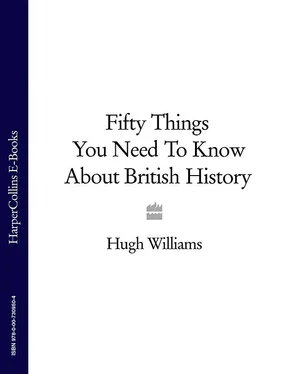The Romans took Britain very seriously, grasping possession of their new province with ferocious speed. Within seven years of Claudius’s triumph they had established a base at London, built a bridge across the Thames and begun to construct a road network throughout the south of England. Caractacus came out of Wales to confront them but was betrayed by a rival tribe and sent as a prisoner to Rome where Claudius pardoned him. Ten years later, Boudicca, the Queen of the Iceni in the east of England, attacked Colchester, London and St Albans. Apparently tall with long, red hair, Boudicca, and her army of tribesmen, succeeded in terrifying the Roman invaders. In 61 AD her vast troop of footsoldiers and charioteers, their women and children watching from wagons drawn up around them, faced a much smaller Roman force. The site of the battlefield is not known, but it is believed to be in the Midlands, possibly near what is now Wroxeter in Shropshire. Roman discipline utterly defeated British size. Tens of thousands of men, women and children were slaughtered by the victorious forces of the Empire and Boudicca herself died shortly afterwards, perhaps by her own hand.
By the end of the 70s AD most of England was under Roman control; however the Britons of Scotland remained unconquered. Agricola, who became Governor of Britain in 78 AD, decided to carry the fight into their territory and won a major victory at Mons Graupius near Aberdeen in 84 AD. He claimed that Scotland had been subdued, but in this he spoke prematurely.
At Mons Graupius the commander of the Britons made a speech to his troops in which, the Roman historian Tacitus tells us, he told his men that they were all loyal to one united race. The Roman troops, he cried, had no such glorious unity because they came from all over the world. His description of the Roman army’s origins was quite accurate, although he was unwise to assume that this was a military weakness. The Roman Empire was by its very nature cosmopolitan and the men who fought for it came from many different backgrounds. Aulus Plautius, Claudius’s commander, had been a provincial governor in Eastern Europe, in what is now Hungary and Austria. Suetonius Paulinus, the commander who defeated Boudicca, was the first Roman general to cross the Atlas Mountains in North Africa. Agricola, the victor at Mons Graupius – and, incidentally, Tacitus’s father-in-law – was born in southern France, in what is now Provence. The conquest of Britain was carried out by men whose home was where duty took them. Wherever they were – in the African desert, the German forest, the English fen or the Scottish mountain – they rigorously applied their abilities to the cause of imperial victory.
Apart from Claudius, two other Emperors stand out as having an important part to play in the history of Roman Britain. The first, Hadrian, became Emperor on the death of Trajan in 117 AD. He turned out to be a highly competent ruler, conscientious and interested in learning about the territories he controlled. Like many Emperors of Rome, he had to watch his back: he had enemies everywhere. He therefore undertook long visits to the furthest outposts of the Empire to meet the troops who defended it. This was a wise strategy. It inspired loyalty in men who, separated from central government by long tours of duty in remote corners of the world, could become tempted into revolt. Hadrian seems to have enjoyed these expeditions, taking satisfaction from the task of securing his Empire’s frontiers. In 122 AD he came to Britain at a time when, as far as we can tell, the northern part had been suffering from the invasion of barbarian tribes. Determined to put a stop to these – and to indulge in his love of building – the Emperor decided to construct a wall across Roman Britain’s northern frontier. Picking the narrowest neck of territory that he thought suitable for the purpose, he built a great stone defence system from the estuary of the River Tyne in the east to the shores of Solway Firth in the west. This was Hadrian’s Wall, 80 Roman miles long (73.5 in modern miles) with a small fort at one-mile intervals along the whole stretch of it. The size and shape of the wall changed as the Romans developed their thinking during its construction; most of it was completed within eight years. It was the biggest fortified frontier in the whole of the Roman Empire, a resolute emblem of its enormous power. After Hadrian died in 138 AD his successor, Antoninus Pius, who may have decided that he needed a military exploit to prove that he was not too mild-mannered, decided to reoccupy southern Scotland. He ordered his legions to move north and built another wall – the Antonine Wall – from the Firth of Forth to the Firth of Clyde. With an eye to economy he had it made out of turf. But the Pictish tribes of Scotland proved hard to subdue. When Antoninus’s successor, Marcus Aurelius, came to power the Romans retreated to behind Hadrian’s great edifice where they stayed until the time came for them to leave altogether. Marcus Aurelius is today remembered more for his writings as a stoic philosopher than as an Emperor, and in the rearrangement of Britain’s northern defences he seems to have taken a leaf out of his own book: ‘That which is not good for the bee-hive,’ he wrote, ‘cannot be good for the bees.’
The other great Roman Emperor inextricably caught up in the affairs of Britain was Constantine. In 305 AD he left the intrigues of the capital of the Empire behind to campaign with his father, Constantius, in Britain. Constantius was a Caesar, a junior emperor in charge of the northern provinces. Father and son fought against the Pictish tribes still untamed north of Hadrian’s Wall, but in 306 Constantius died at York. His troops then proclaimed his son Emperor, even though the Praetorian Guard in Rome had nominated a rival, Maxentius. Some historians believe that Constantine built the great Roman walls around York at the time of his proclamation. Whatever the truth there is no doubt that at a crucial moment in the history of the whole Roman Empire, this ancient British city became the centre from which its future sprang. From there Constantine would go on to defeat his rival outside the gates of Rome and, as one of the greatest Emperors in the last century of Roman power, tolerate the rise of Christianity, create a new capital in Constantinople and die converted to the Christian religion.
The country developed from a wild, barbarous land into a unified self-governing province – Britannia.
The impact of the Roman occupation on Britain was profound. The country developed from a wild, barbarous land inhabited by fierce tribes into a unified self-governing province – Britannia. A network of roads linked all corners of the land; a single currency created a coherent market for trade; and the refinements of Roman civilisation brought fine buildings and magnificent fortifications to the towns and cities. Latin became the language of law and education. The British adopted the customs and attitudes of their governors: many of them wore togas. British metals were taken back to the heart of the Empire to be fashioned into weapons and armour, and wine and exotic fruits made their way northwards in return. Britain developed into what it would become again – a trading nation. But no empires last forever. By the end of the fourth century AD, Britain, like the rest of Rome’s once indomitable possessions, was suffering from invasion on all sides. The Empire had finally cracked in two with an eastern half based in Constantine’s capital of Constantinople and a western part still trying desperately to cling to power in Rome. In 410 AD the last Emperor of the western Empire, Honorius, told the people of Britain that he had no legions left to defend them. Britannia, Rome’s most northerly outpost, the troublesome island that had over four centuries succumbed to its power and become one of its most precious possessions, was abandoned. The unity of Roman Britain broke apart and the country surrendered to the tribal ambitions of foreign marauders. The Dark Ages had begun.
Читать дальше












